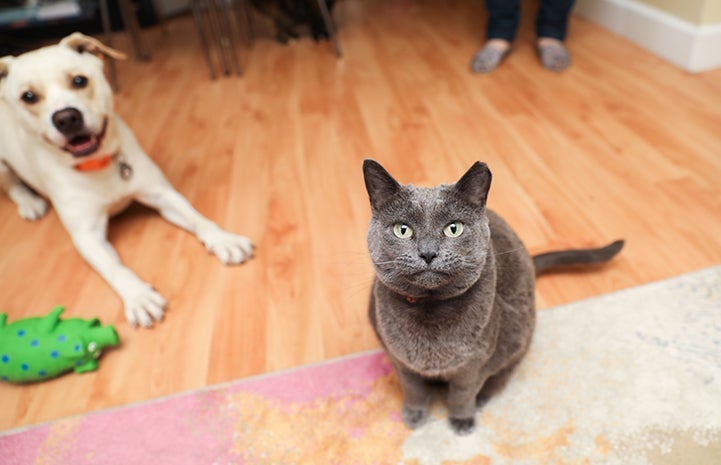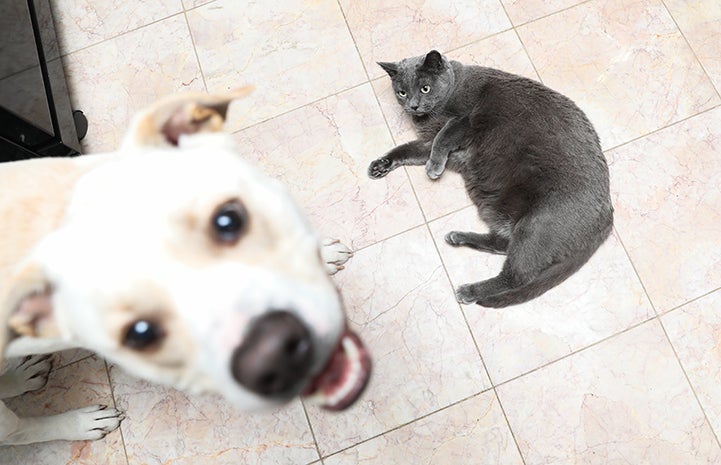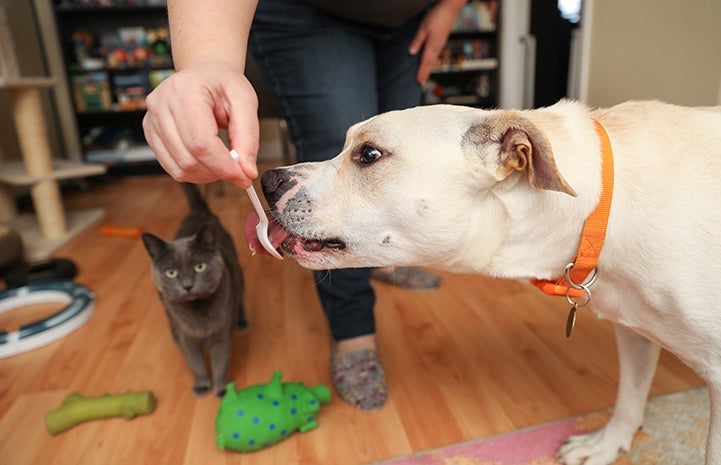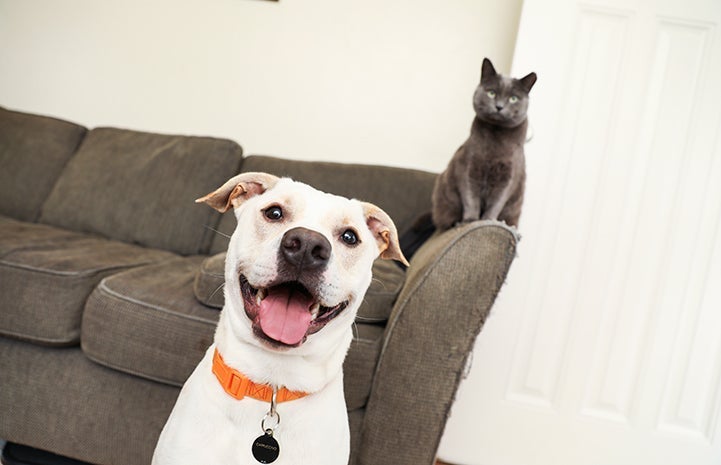
How to Introduce a Dog to a Cat
How to introduce a dog to a cat depends largely on the individual animals. Some dogs do fine living with cats; others simply cannot live safely with felines. And sometimes, a dog can live with certain cats — depending on their age, temperament, and activity level — but not others. Even if your dog has successfully lived with cats in the past, it is important to remember that each dog and each cat is an individual, environments are different, and each introduction is different.
Body language of dogs and cats
When introducing your dog to a cat, pay attention to the body language of both animals. If the cat’s ears are pinned back or their tail is swishing back and forth, this is a good indicator that they’re displeased.
You particularly want to be aware of dog body language that could be potential warning signs. If your dog has a strong prey drive (the inclination to seek out, chase, and potentially capture animals seen as prey), they might become very focused on the cat. The dog will stiffen, stare, and possibly bark or whine.
If you see these signs, do not let your dog near the cat. Ideally, the dog’s body language will be loose and relaxed around the cat. It’s OK if your dog pays attention to the cat, but you don’t want to see a dog fixated on a cat.
In addition, a dog’s interaction with a cat can change depending on the environment. Just because your dog is comfortable with the cat inside the house, that doesn’t mean the dog will exhibit that same behavior outdoors. They might fixate on the cat and start stalking or chasing the cat when they are outside together. So be aware of your dog’s body language around the cat in each new situation until you know how they're going to respond.
Methods for introducing a dog and a cat
There are many different ways to introduce a dog to a cat. If the first method of introduction you try doesn’t work or you don’t feel comfortable with it, try a different option. Even if the dog has had experience with cats and the cat has lived with a dog before, proceed cautiously during the introduction.
It’s best to have two people present — one to intervene with each animal if necessary. If you have more than one dog, introduce each dog separately to the cat.

Option 1: Slow and steady desensitization
If your dog is too fixated on the cat, you can try desensitization — the goal of which is to reduce your dog’s reaction to the cat by gradually increasing exposure.
Put the cat in a room (e.g., a bedroom, bathroom, or spare room) with a tall baby gate across the door. The room you choose should be one the dog cannot access and doesn’t need to access. For example, if the dog sleeps in the bedroom with you at night, don’t pick that room for the cat. The idea is to separate them and only allow them to view each other during specific times.
Give the cat all the necessary supplies in their room: litter box, toys, food, and water. Keep in mind that cats are good at squeezing through small gaps and are also good climbers and jumpers, so make sure your cat can’t get past the gate you put up. The gate needs to be a barrier that allows the cat and dog to see one another but does not allow them to access each other.
To begin desensitization, let the dog view the cat briefly through the gate, and then get the dog to focus on something else, such as playing with a toy or practicing cues. Sometimes it helps to keep the dog on leash so that you can move away from the cat when you try to refocus the dog's attention. Praise and reward the dog for being able to focus elsewhere. Continue to give the dog short viewings of the cat throughout the day.

See how your community is doing
Sometimes, even seeing the cat at first is too exciting for the dog. If this is the case, close the door and begin feeding each animal on their side of the door: The cat eats in the room right next to the door, and the dog eats on the other side of the door. This allows each animal to associate the smells of the other with something good: food. You can also swap out the blankets and bedding of each animal, giving it to the other. That way, the dog can get used to the cat’s smell and the cat can get used to the dog’s smell, without overstimulating either of them.
Hopefully, through this process of slowly letting the dog see the cat and get accustomed to the cat’s presence, the dog will eventually become desensitized and lose interest in the cat. In some cases, the dog will lose interest in the cat within a couple of hours. But it can take days, weeks, or even months. Each dog (and each cat) is an individual and will learn at their own pace.
It is possible that your dog might not ever be able to safely share space with a cat. If you don’t feel you can trust your dog around your cat, you should keep them apart, especially if you are not home or not able to supervise. Dogs can injure or kill a cat very quickly, and your dog can also be injured by the cat. Your first priority should be ensuring that everyone stays safe.

Option 2: Face-to-face introduction
This is a more fast-paced introduction. One person should hold the dog on a loose lead and watch the dog’s body language. Someone else should watch the cat’s body language. If the cat is not raising their back or hissing around the dog, they can be allowed to move around freely. A cat is rarely a threat to a dog, but some cats will be on the offensive when meeting dogs.
If the dog is calm around the cat, you can ask the dog to sit (or lie down) and stay, if they’ve been taught those cues, while the cat moves about freely, sniffing the dog if desired. The dog should be praised and rewarded for ignoring the cat. If the dog is too fixated on the cat (e.g., staring at the cat, has stiff body language, will not listen to you when you call their name) or if the dog lunges and tries to chase the cat, you should try a different strategy for getting them to share space, such as option 1 or option 3.

Option 3: Look at that
If the quick introduction did not work and your dog is not becoming desensitized to the cat, you might need to try some more structured training. By playing “look at that” (LAT) with your dog, you can help to teach them not to fixate on the cat. You’ll be teaching your dog to look at the cat and then look back at you for a treat. Essentially, your dog will learn that it is more rewarding to not pay attention to the cat.
To start working on LAT, you need to figure out the dog’s threshold while on leash: At what point does the dog notice the cat but still respond to you when you say your dog’s name? That is the dog’s threshold.
Each dog has a different threshold. For one dog, 5 feet away from the cat might be the threshold; for another dog, it might be 25 feet. You’ll know you have gone past the threshold when your dog starts barking or lunging at the cat. Another sign that you’re getting too close to the cat is if your dog starts moving more slowly, staring and stiffening. If you call your dog’s name and don't get a response, move a few feet away from the cat.
Once you’ve figured out the dog’s threshold, grab a clicker and some really delicious, pea-sized treats. If you don’t have a clicker, a verbal marker “yes” will work just fine. Put a handful treats in your hand, and keep the bag close by for later.
When you see the dog looking at the cat, click or use your verbal marker and offer a treat. The first few times, you might have to put the treat right in front of your dog’s nose, but fairly soon your dog should start looking expectantly at you as soon as they hear the marker. That’s because the marker (either a clicker or “yes”) always means a treat is coming.
Start waiting your dog out, and only mark if your dog will look at the cat and then look right back at you. If they do, either click or use the verbal marker when your dog looks at you and then offer a treat. Only do this if your dog is able to remain calm and relaxed around your cat.
Once your dog is reliably looking at the cat and then looking back at you, you can slowly start moving closer and closer to the cat. If the dog becomes fixated on the cat when you move closer, you’ve gone past the threshold and need to move back.
As you train, your dog’s threshold will decrease, which means that the two of you will be able to move closer and closer to the cat. Continue practicing LAT with your dog until they can be right next to the cat without an issue. How quickly your dog’s threshold decreases will depend on you (how much you practice and the types of treats you use), your dog (because every dog learns at a different pace), and your cat’s comfort level.

Introducing kittens and puppies
If you are introducing a kitten to a dog, keep in mind that kittens might not have any fear of dogs, so you must watch the dog carefully. Because kittens are small and want to run and play, dogs with a strong prey drive might be very excited by a kitten’s movements.
Even if your dog is OK with your adult cats, it is important to watch closely when your dog is with a kitten. If your dog is young and high-energy, they could hurt or kill the kitten simply by trying to play. So, for safety’s sake, keep kittens and dogs apart any time you are not watching them.
Introducing adult cats to puppies can sometimes be easy; a well-socialized adult cat might be fine with a puppy acting like a puppy. However, if your rambunctious puppy is chasing your shy cat, it is up to you to intervene. Until the puppy is old enough to have more self-control and has had some training, you will want to manage their interactions. You don’t want your puppy to learn that chasing the cat is a fun game.
Baby gates can be used to keep the animals safely and comfortably apart. To help you keep an eye on your puppy, you can also put them on a leash. That way, if the puppy begins to chase the cat, you will be able to easily direct them away from that behavior.
Seeking help from a professional
Animals with good past experiences often adjust well and quickly to a new pet in the house. But if introductions don’t go well, seek help from a professional dog trainer or behavior consultant. Remember to take things slowly and at your pets’ speed. A negative interaction could ruin the relationship, and you’ll need to start over.
